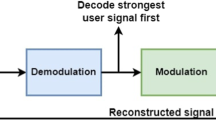Abstract
Software defined physical layer modems can be considered the new trend in the field of communications. Differently from dedicated hardware, software can be easily modified to implement a large variety of standards on the same platform. The use of software can significantly reduce development costs, but generally comes at the price of an increase in silicon area and power consumption. For different reasons, this price is something that is not always convenient or even possible to pay, as in the case of low-cost ICs implementing a single waveform, or even multi-mode modems embedding legacy IPs already available in hardware. In particular, power consumption overhead can be prohibitive for mobile terminals or in general for battery-powered devices. The very first challenge for a computing fabric to be competitive is to find and implement the right trade-off between flexibility and performance. This was the guideline for the design of the Block Processing Engine (BPE), a template architecture conceived for power-efficient baseband processing. The BPE core feature is a mixed-grain instruction set balancing general-purpose fine-grain instructions with more specific coarse-grain instructions wrapping custom hardware modules. To further limit the power consumption, the BPE also implements instruction-pipelining, variable-size SIMD and multi-task support. To prove the efficiency of such an approach, a dual-mode IEEE 802.11a/p receiver has been implemented.






Similar content being viewed by others
References
IEEE Std 802.11 (ISO/IEC 8802-11: 1999). IEEE Standards for Information Technology – Telecommunications and Information Exchange between Systems – Local and Metropolitan Area Network – Specific Requirements – Part 11: Wireless LAN Medium Access Control (MAC) and Physical Layer (PHY) Specifications.
IEEE P802.11p-2010 (2010). Part 11: Wireless LAN Medium Access Control (MAC) and Physical Layer (PHY) Specifications. Amendment 6: Wireless Access in Vehicular Environments.
IEEE 802.11a-1999 (1999). Standard. Part 11: Wireless LAN Medium Access Control (MAC) and Physical Layer (PHY) Specifications: High-speed Physical Layer in the 5 GHz Band.
Anjum, O., Ahonen, T., Garzia, F., Nurmi, J., Brunelli, C., & Berg, H. (2011). State of the art baseband DSP platforms for software defined radio: a survey. EURASIP Journal on Wireless Communications and Networking, 2011, 5.
van Berkel, K., Heinle, F., Meuwissen, P. P. E., Moerman, K., & Weiss, M. (2005). Vector processing as an enabler for software-defined radio in handheld devices. EURASIP Journal on Applied Signal Processing, 2005(no. 16), 2613–2625. doi:10.1155/ASP.2005.2613.
Liu, D., Nilsson, A., Tell, E., Wu, D., & Eilert, J. (2009). Bridging dream and reality: programmable baseband processors for software-defined radio. Communications Magazine, 47(9), 134–140.
Bougard, B., De Sutter, B., Rabou, S., Novo, D., Allam, O., Dupont, S., et al. A coarse-grained array based baseband processor for 100Mbps + software defined radio. In Proceedings of the conference on Design, automation and test in Europe (DATE ’08). ACM, New York, NY, USA, pp. 716–721.
Eberli, S., Burg, A., Bösch, T., & Fichtner, W. (2007). An IEEE 802.11a baseband receiver implementation on an Application Specific Processor. Proceedings of IEEE Midwest Symposium on circuit & Systems, Montreal, Quebec, Canada, pp. 1324–1327, Aug 2007.
Ramadurai, V., Jinturkar, S., Agarwal, S., Moudgill, M., & Glossner, J. (2006). Software Implementation of 802.11a blocks on Sandblaster DSP. Proceedings of Software Defined Radio Technical Forum (SDR Forum ’06), Orlando Florida, November, 2006.
Schmidt-Knorreck, C., Knorreck, D., & Knopp, R. (2012). IEEE 802.11p receiver design for software defined radio platforms. DSD 2012, 15th Euromicro Conference on Digital System Design, 5–8 September, 2012, Cesme, Izmir, Turkey.
Chen, Y.-H. et al. (2012). A novel multicore SDR architecture for smart vehicle systems. Proc. of the 12th Int. Conf. on Intelligent Transport Systems Telecommunications (ITST), November, 2012.
Lo Iacono, D., Zory, J., Messina, E., Piazzese, N., Saia, G., & Bettinelli, A. (2006). ASIP architecture for multi-standard wireless terminals. In Proceedings of the conference on Design, automation and test in Europe: Designers’ forum (DATE ’06). European Design and Automation Association, 3001 Leuven, Belgium, Belgium, 118–123.
Cupaiuolo, T., & Lo Iacono, D. (2010). Software Implementation of Near-ML Soft-Output MIMO Detection. Washington, DC, USA, 30 November–3 December, 2010, Software Defined Radio Forum 2010 (SDR’10).
Volder, J. (1959). The CORDIC trigonometric computing technique. IRE Transactions on Electronic Computers.
Schmidl, T. M., & Cox, D. C. (1997). Robust frequency and timing synchronization for OFDM. IEEE Transactions on Communications, 45, 1613–1621.
Dall’Anese, E., Assalini, A. & Pupolin, S. (2007). On reduced rank channel estimation and prediction for OFDM-based systems. In Proc. Int. Symp. on Wireless Pers. Multimedia Commun., Jaipur, India, Dec. 2007.
Tosato, F., & Bisaglia, P. (2002). Simplified soft-output demapper for binary interleaved COFDM with application to HIPERLAN/2. In: Proceedings of IEEE International Conference on Commun., New York, April/May 2002, pp. 664–668.
Siti, M., Assalini, A., Dall’Anese, E., & Pupolin, S. (2010). Low complexity decision-directed channel estimation based on a reliable-symbol selection strategy for OFDM systems (2010). IEEE International Conference on Communications (ICC’09) - Workshop on Vehicular Connectivity - Cape Town, South Africa, 23–27 May 20.
Cupaiuolo, T., Lo Iacono, D., Siti, M., & Odoni, M. (2012). Software implementation of the IEEE 802.11a/p physical layer. SDR’12-WInnComm-Europe, June 2012.
Jarbot, L. (1997). Combined decoding and channel estimation of OFDM systems in mobile radio networks. Proceedings of the IEEE Vehicular Technology Conference, 3, 1601–1604.
Author information
Authors and Affiliations
Corresponding author
Rights and permissions
About this article
Cite this article
Lo Iacono, D., Cupaiuolo, T. Power Efficient SDR Implementation of IEEE 802.11a/p Physical Layer. J Sign Process Syst 73, 281–289 (2013). https://doi.org/10.1007/s11265-013-0773-z
Received:
Revised:
Accepted:
Published:
Issue Date:
DOI: https://doi.org/10.1007/s11265-013-0773-z




